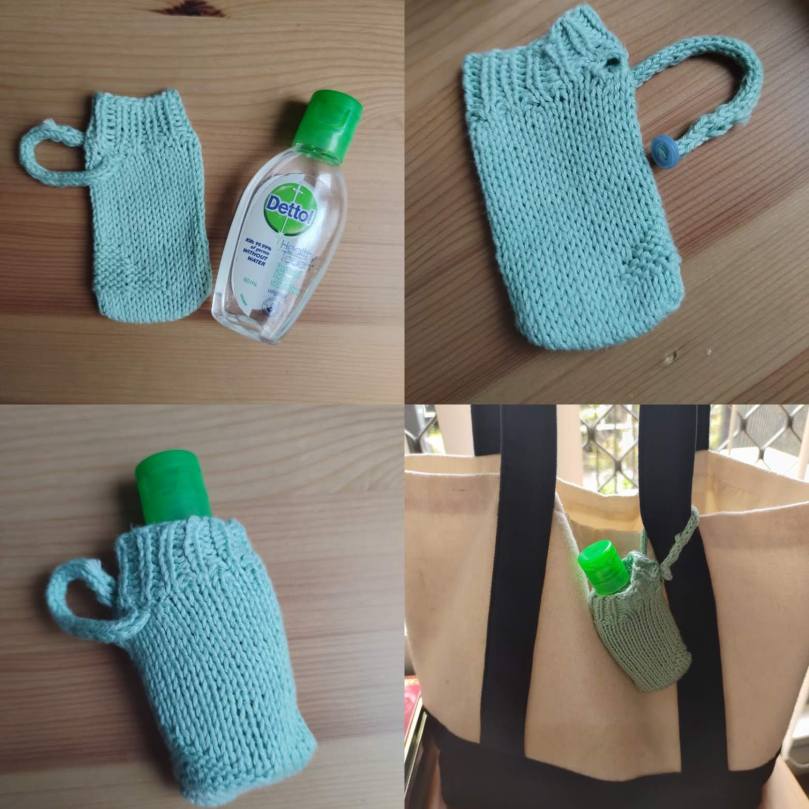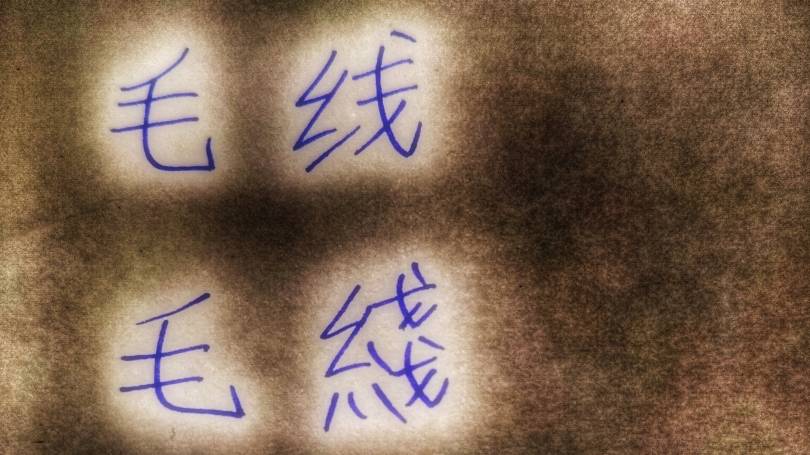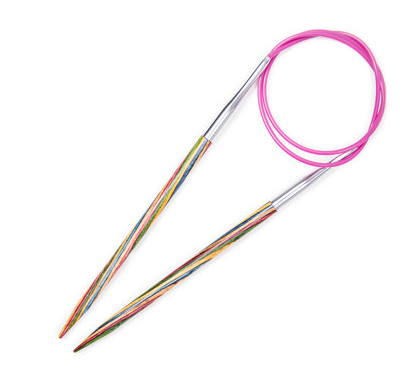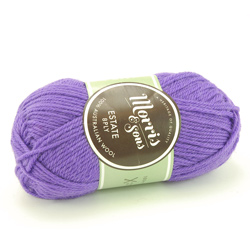
A small pouch to carry a travel bottle of hand sanitiser and attach to a bag or purse. This was designed for the Dettol 50ml bottles sold in Australia, but can be easily adapted for other types.
Get the pattern here:
Sometimes beginner knitters ask me for advice on a first project. Sometimes, in my knitting group, we discuss what good first projects are. What’s the first thing a new knitter should make? They’ve learnt how to do the basic stitches [aside: there are only two stitches in the whole knitting, and anyone who tells you otherwise is lying, but that’s by the bypass] and now they want to actually make something! What should that thing be?
You’re going to say a scarf. I know you’re going to say a scarf. And John Avocado’s advice for a first project is: do not make a scarf.
If you decide to make a scarf for your first project, there’s a good chance that the main outcome of this project will be that you will hate knitting. This is because there are only two types of scarf: (a) easy and boring, and (b) interesting and difficult. Neither of those is suitable for a beginner. And in fact, those two types are really just subtypes of the one type of scarf that there is: long.
A basic scarf will probably be about 60 inches long and 6 inches wide, and a garter stitch scarf that size using a 10-ply/worsted weight yarn like Cascade 220 at the recommended gauge will have between 14,500 and 18,000 stitches. All knit stitches. And that’s a lot of stitches. And a lot of the same stitches. Over and over and over. Even something like Stephanie Pearl-McPhee’s One Row Handspun Scarf, while a bit les monotonous, is a big project with a lot of stitches, and a new knitter who just wants to get their first project finished really risks getting bored, or resenting a project that seems to be taking so long to finish.
The other reason is that new knitters tend not to be very good at knitting. And there’s no shame there! It’s part of the process of learning to knit: nobody starts good, and people only get better at knitting with practice. When I started knitting, my tension was uneven, my stitches were sloppy, my edges were a mess, and certainly not straight (and though, I should add, straight is not something I strive for generally in life, for the edges of a basic scarf, it’s normally seen as a requirement), and I think this is the case for most new knitters. And the result is that a new knitter embarking on their first project will end up spending a lot of time and effort (and often money!) on this big project, and end up having made something that does not look good. And the risk is that they’ll be so disheartened that they decide they hate knitting and never pick up the needles again.
So I’m very clear when I say to new knitters choosing a first project: do not make a scarf. The chances that this will lead to disappointment are just too high.
So, what to knit? As with choosing any knitting project, I think it’s a good idea to think about what you want to get out of the process: not just the thing you make, but the experience of making it. Do you want a challenge? Do you want to learn new skills or just practise existing ones? There are many considerations, but I think most new knitters have similar goals: they want a first project to be easy and reasonably quick, they want to actually have a finished piece, and it should look reasonably good.
My friend Heather had this dilemma a couple of months ago, and my advice to her was to make something small. And in fact, I recommended the One Row Scarf, but in bookmark size. That way, she’d finish a project before she gave up, would have something that was useful, and would have have something where it wouldn’t matter too much if the stitches didn’t look perfect. (I should add here that the bookmark she made on my recommendation looked stunning.)
Another idea for a first project would be a hat. A basic beanie, nothing fancy. A hat comes together much quicker than a scarf, and it doesn’t have edge stitches (it’s either knitted in the round, or the edge stitches end up in the seam), so the main areas of a piece looking less good disappear. I like the Cozy Cobblestone Cap as a first project: it’s simple, has a mix of knit and purl stitches, as well as decreases and seaming so it’s not boring, it looks good, and it’s knitted flat (I know new knitters tend to be scared of knitting in the round (I certainly was!), and often the only needles a beginner has are straight needles, so I know it’s a consideration).
In summary, a scarf is a big project that will either be boring or difficult, and so it’s not my pick for a first project. Think about what you want to get out of the experience of a first project, and pick something that you can finish quickly, and that will be easy, but with a bit of variety in the stitches to keep you interested and engaged. Most importantly, pick something that you want to have!
Have fun with your knitting, and good luck!

Like a lot of people, I think, 2020 was a year when I had quite a lot of downtime for knitting, but overall it felt a bit flat. For most of the year, my attention span was so very short, and I felt I only had the energy for small, quick projects. And for a lot of the year I was knitting alone: because of COVID-19, my knitting group moved to meeting online from March until around July, and even though the sense of connection was there, knitting (and crochet!) is so much about touch, and sharing what we were working on with the rest of the group just wasn’t quite the same via Zoom (it was actually Google Meet, but that’s neither here nor there).
I do feel a small sense of accomplishment, looking back at 2020 though, as I did get quite a few of those small and quick projects finished. I started the year with the Ex-boyfriend Socks (Nathaniel bought me some lovely alpaca yarn from Hahndorf as a “break up gift” (who knew that was a thing!) and I turned it into socks and gave it back to him). I made accessories for Mardi Gras (an earring and a crown) out of the rainbow acrylic yarn I got for cheap in Lincraft’s closing down sale, and during lockdown I made three pairs of socks for myself, two pairs of mittens, and I had a go at embroidery onto knitted fabric with duplicate stitch.
But there were a few speed bumps in my knitting too. After lockdown, in June, I started on a pair of cotton socks, and I hated knitting them so much, it took months to finish them. I found out via these socks that I hate working with cotton yarn, and even worse. I made the mistake of using a dark colored yarn on black needles (KnitPro Karbonz, which are by far my favorite needles), and I ended up losing any enthusiasm I had for knitting at all. And the Manta shawlette, the one I was so excited about at the end of the year progressed slowly, and is now indefinitely on hold: the pattern isn’t all that fun to work (it’s fiddly lace, has too many SSP stiches in it, and is worked around a double yarn-over in the middle which makes it feel like the whole thing is going to fall apart at any time) so I wasn’t enjoying knitting it, and in November the pattern designer went on a full-on “reverse racism is a thing” rant on Instagram, so I just didn’t want to work his pattern any more.
I figured I wouldn’t be able to send knitted gifts home for Christmas this year because of postal delays: Australia Post had consistently only been offering a very limited service to the UK for much of the year, but I checked the Australia Post website in late October, and they’d re-introduced Express Post to the UK, so in two weeks (!!) I managed to knock out two pairs of socks and two pairs of gloves and made the Express Post last date for Christmas. That early deadline, of course, gave me time to make a hat for Adrian.
Over the Christmas period, I worked on another pair of socks for myself (very very basic ones), two jockstraps (one as a gift for a friend in Japan), and I started work on the Anubias shawl, which is very exciting.
As we move into 2021, I’ve found my enthusiasm for knitting again, but I do want to plan my projects this year, rather than just doing whatever I feel like when I feel like it (I think that was part of the problem with 2020: I didn’t have a plan so it all felt very erratic).
The first part of the plan involves always having a pair of socks on the go. I never saw myself as a sock knitter, and I still don’t really, but I do quite like knitting socks, they don’t require a lot of *inspiration*, and I find them a good way of always feeling like I’m making progress. January’s socks are already finished, so I’m ahead of schedule (shhh, I cheated: they’re the basic basic socks that I started in December), and work on February’s socks can start. I bought some gorgeous hand-dyed yarn from my friend Mel, and I’m planning a pair with a lace panel running up the front and instep. After that, my Instagram friend Matt Akers (who I have a crush on) designed a collection of socks for Pride, so I might give one or two of his patterns a go.
I’ve already started planning for Christmas, including two jumpers (my nephew will be getting a Tin Can Knits FLAX sweater for Christmas) as well as a couple of Fair Isle projects.
As well as finishing the Anubias shawl, working on my Christmas projects, and always having socks on the go, I have plans for some smaller projects that I will be working on to break things up a bit, and to make sure I get some things actually finished fairly regularly. Another Instagram friend, Duke Akiba (who I also have a crush on) designed a gorgeous hat called 绿 Midori (which is the Japanese word for green) and I’m looking forward to starting that in February. Duke is also the king of double knitting (I made his 水酒 Mizu Sake coaster last year and love it), and I’m planning to use his double knitting principles, as well as Amimoji principles and try to make a double knitting coaster with the character 愛, which means “love”.
There’s more planning to do, and I’m sure things will change as the year progresses, but for 2021’s knitting, I’m feeling much calmer, much more organised, and much more enthused!
A question I often answer and am sometimes asked is:
I want to learn to knit; what basic supplies do I need?
I’m going to answer this with what I think are the basics, with some specific recommendations on products. Note, this is my biased view; other people will give you different advice, but this is definitely my opinion on the best and most versatile products to get started with.
A note: while understanding that you don’t want to spend a lot of money initially, knitting is an expensive hobby. You can, of course, buy a pair of needles and some acrylic yarn from the $2 store and knit with them, but I promise you that you’ll hate knitting if you do that.
I think for beginners, the best way to get started is to buy a 24″/60cm circular needle, size 4mm or 4.5mm (US size 6 or 7), and made of wood. (A lot of beginners start with bamboo, but I think that’s way too sticky. While having a bit of grip is good so your stitches won’t fall off the needle, if you’re constantly dragging the stitches along it will be irritating and you won’t enjoy knitting.)
With a circular needle you’ll be able to practise basic flat knitting, as well as circular knitting and magic loop knitting.
I am going to recommend KnitPro Symphonie fixed circular needle size 4mm. It’s AU$10.38 from LoveCrafts – or check your local yarn store.

There are loads of yarns available and it can be very confusing when you’re starting out. Most beginners start with acrylic yarn because it’s cheap and available everywhere – DON’T DO IT. The quality of cheap acrylic yarn can be so bad that it is genuinely unpleasant to knit with, and you’ll end up thinking you hate knitting when you just hate the yarn.
I recommend starting with wool yarn, in weight 4/medium/worsted/10-ply (it’s all the same thing, just different names depending on your location). Buy two 50g balls in two different light colors.
This weight of yarn is probably the easiest to work with, and your stitches will be big enough for you to see. It’s also a good weight for your needles. Wool generally feels nice to work with and is really forgiving. It’ll have a bit more grip on your needles too. It’s really important to get light colors so you’ll be able to see your stitches easily.
If you’re in Australia I recommend Morris & Sons Estate 10-ply available from their website for AU$6.45.

Aside from needles and yarn, there are a couple of other things I recommend you get. Not essential, but they’ll make life easier.
I think going to a beginners’ class at your local yarn store is the best way to get started, but that might well be impractical or unaffordable. There are lots of YouTube channels, some of them are good, and some of them are not. I recommend VeryPink Knits – Staci Perry of VeryPink is an excellent knitting teacher, and her videos are very well produced.
Please feel free to get in touch if you want more advice or if you dispute any of this! I’d love to chat knitting with you!